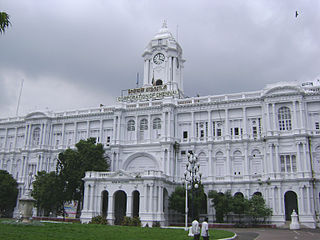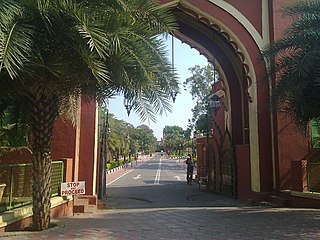Bharat Insurance building is a heritage building in Chennai, India. Located on the arterial Anna Salai, it was built in 1897. Originally known as Kardyl Building, the building is an example of the Indo-Saracenic architecture, a hybrid of Muslim design with Indian materials. [1]
The Madras High Court has stayed demolition of the building following a petition from heritage lovers.
The building with stained glass panels, domes, spires, arches, verandahs and 100-ft minarets was built in 1897. Once a lively commercial centre, it started deteriorating due to poor maintenance. The ownership changed several hands before it came under the possession of the Life Insurance Corporation of India (LIC) in 1956. In 1998, tenants were asked to vacate the premises due to the weakness of the structure, and LIC planned to demolish the building in 2006. [2] The Madras High Court stayed it after the Indian National Trust for Architectural and Cultural Heritage (INTACH) filed a public interest litigation. INTACH received an interim order to preserve the building. LIC appealed to the Supreme Court which referred the matter back to the Madras High Court. The High Court issued a comprehensive order in 2009, asking the state government to submit a report on the building and also form a conservation committee to handle protection of other heritage structures. The heritage committee said in its report to the High Court that the building should be preserved, reiterating its heritage value. Meanwhile, LIC filed a petition with the Supreme Court in 2010, citing a technical report to argue that the building is structurally unsound and that it should be allowed to redevelop the property so it will resemble the old building in design. It also stated that the building has not been listed as a heritage structure anywhere and proposed an eight-storeyed complex in its place. The government made an announcement in October 2010 about finalising a heritage bill. [3]
The Madras High Court in a landmark judgement in 2010 included the building in a set of 400-plus heritage structures that could not be demolished. The grade 'A' certification was also confirmed. [4]

Dr. Ambedkar Government Law College, commonly known by its former name Madras Law College, is a law school, located in Chennai (Madras), Tamil Nadu, India. It is also referred to as Government Law College or GLC, Chennai. It was established in 1891. It was renamed in 1990, as Dr. Ambedkar Government Law College, by the Government of Tamil Nadu in commemoration of the birth centenary of B. R. Ambedkar, the father of Indian constitution. In 1997, the Government of Tamil Nadu passed an Act which brought the college under the wings of the newly established Tamil Nadu Dr. Ambedkar Law University, splitting the college from the University of Madras.

The High Court of Karnataka is the High Court of the Indian state of Karnataka and thus its highest judicial authority. The court's principal bench is located in Bengaluru, the capital city of Karnataka, with additional benches in Hubballi-Dharwada and Kalaburagi. It was previously called the High Court of Mysore. In Bengaluru, the High Court functions out of a red-painted brick building known as the Attara Kacheri, located opposite the Vidhana Soudha, the seat of the Karnataka Legislature.

Chennai architecture is a confluence of many architectural styles. From ancient Tamil temples built by the Pallavas, to the Indo-Saracenic style of the colonial era, to 20th-century steel and chrome of skyscrapers. Chennai has a colonial core in the port area, surrounded by progressively newer areas as one travels away from the port, punctuated with old temples, churches and mosques.

Vivekanandar Illam, earlier known as Ice House or Castle Kernan, is a historical building in Chennai, India. It was constructed in 1842 by Frederic Tudor. Indian Saint Swami Vivekananda stayed in the building when he visited Chennai in 1897, and it was later renamed in his honor. It is currently maintained by Ramakrishna Math and houses an exhibition on the life of Vivekananda.

The Ripon Building is the seat and headquarters of the Greater Chennai Corporation in Chennai, Tamil Nadu. It is an example of neoclassical architecture, a combination of Ionic and Corinthian styles. The Ripon Building is an all-white structure and is located near the Dr. M.G.R Railway Station.

Anna Salai, formerly known as St. Thomas Mount Road or simply Mount Road, is an arterial road in Chennai, India. It starts at the Cooum Creek, south of Fort St George, leading in a south-westerly direction towards St. Thomas Mount, and ends at the Kathipara Junction in Guindy. Beyond the Kathipara Junction, a branch road arises traversing westwards to Poonamallee to form the Mount-Poonamallee Road while the main branch continuing southwards to Chennai Airport, Tambaram and beyond to form Grand Southern Trunk Road. Anna Salai, which is more than 400 years old, is acknowledged as the most important road in Chennai city. The head offices of many commercial enterprises and public buildings are located along Anna Salai. It is the second longest road in Chennai, after EVR Periyar Salai.

Victoria Public Hall, or the Town Hall, is a historical building in Chennai, named after Victoria, Empress of India. It is one of the finest examples of British architecture in Chennai and was built to commemorate the golden jubilee of Queen Victoria. It served as a theatre and public assembly room in the late 19th century and the early 20th century. It now houses the South Indian Athletic Association Club.

George Town is a neighbourhood in Chennai, Tamil Nadu, India. It is near the Fort Saint George, Chennai. It is also known as Muthialpet and Parry's corner. It is an historical area of Chennai city from where its expansion began in the 1640s. It extends from the Bay of Bengal in the east to Park town on the west. The Fort St. George is on the south, to Royapuram in the north. The Fort St. George houses the Tamil Nadu Legislative Assembly and the Secretariat. The High court of Tamil Nadu at Chennai, Dr. Ambedkar Law College, Stanley Medical College and Hospital are located here.
The Heritage Conservation Committee under HUDA was formed by state government in 1981 to retain architectural, historical and social value of buildings. Hyderabad Urban Development Authority has listed almost 160 buildings in Hyderabad in Telangana state as heritage structures. Almost 70% of heritage buildings are in private hands. Heritage structures include buildings, monuments, rock structures etc.

LIC Building is a 15-storied building in Chennai, India, serving as the southern headquarters of the Life Insurance Corporation of India. It is the first skyscraper built in Chennai and an important landmark in the city. Located on the arterial Anna Salai, the building is 54 m (177 ft) tall. Initially built with 12 floors, the LIC Building was the tallest building in India when it was completed in 1959 and was surpassed by Mumbai's first skyscraper, the Usha Kiran Building, in 1961, which is about 80 m (260 ft) high. The building marked the transition from lime-and-brick construction to concrete columns in the region. The building is also known for using pile foundation technique for the first time in the region. It was the tallest building in Chennai for over 35 years before being surpassed by the Hyatt Regency Building on Anna Salai and the Arihant Majestic Towers in Koyambedu, both in the mid-1990s.

Chepauk Palace was the official residence of the Nawab of Arcot from 1768 to 1855. It is situated in the neighbourhood of Chepauk in Chennai, India and is constructed in the Indo-Saracenic style of architecture.

Amir Mahal is the official residence of the titular Nawab of Arcot and his family. Situated in Royapettah, a neighbourhood of Chennai, India, it was constructed in Indo-Saracenic style in 1798, the Amir Mahal has been the residence of the family since 1876. The Prince of Arcot, Nawab Mohammed Abdul Ali, lives in the palace with his family.

The Senate House is the administrative centre of the University of Madras in Chennai, India. It is situated in Wallajah Road, along Marina Beach. Constructed by Robert Chisholm between 1874 and 1879, the Senate building is considered to be one of the best and oldest examples of Indo-Saracenic architecture in India.

Kasi Viswanatha Temple is a Hindu temple in Chennai, India. Located in the neighbourhood of Ayanavaram, the temple was constructed by the Tawker clan of Madras' Gujarathi community and was constructed during the time of the East India Company. The temple is situated close to the Medavakkam Tank Road and adjoining the Ayanavaram Bus Depot.

Metropolitan Building is the number 46.26 building on Chowringhee Road in Kolkata near Esplanade. Formerly known as the Whiteway Laidlaw department store, it was a famous department store in Calcutta during the British Rule in India. This neo-baroque emporium—with domes, a clock tower and arched recessed windows—exemplifies fashionable shopping during the British Raj in British India.
Chennai, with historically rich records dating at least from the time of the Pallavas, houses 2,467 heritage buildings within its metropolitan area (CMA), the highest within any Metropolitan Area limit in India. Most of these buildings are around 200 years old and older. Some of them are Chennai Central, Chennai Egmore, Ripon Building, Senate House, Bharat Insurance Building, and so forth. Chennai is home to the second largest collection of heritage buildings in the country, after Kolkata. The official list of heritage buildings was compiled by the Justice E. Padmanabhan committee. The Tamil Nadu Assembly passed the Heritage Commission Act in 2012 to preserve old heritage structures.

The Palika Kendra is a 21-story building on Sansad Marg, New Delhi, India. Designed by Kuldip Singh and Mahendra Raj, it is among the few structures in Delhi that feature Brutalist architecture. After its inauguration in 1984 with a height of 91 metres (299 ft), it remained one of the tallest buildings in Delhi for years. It serves as the headquarters of the New Delhi Municipal Council and hosts the main server and the command and control centre of the civic body.

Justice Ratnavel Pandian Subbiah is a sitting Judge of the Charted High Court of Madras. Subbiah is the Executive Chairman for the Tamil Nadu State Legal Services Authority. He was elevated as a Judge of High Court of Madras on 24 March 2008.

The Madras High Court is a High Court in India. It has appellate jurisdiction over the state of Tamil Nadu and the union territory of Puducherry. It is located in Chennai, and is the third oldest high court of India after the Calcutta High Court in Kolkata and Bombay High Court in Mumbai. The Madras High Court is one of three high courts of colonial India established in the three Presidency Towns of Madras, Bombay and Calcutta by letters patent granted by Queen Victoria, dated 26 June 1862. It exercises original jurisdiction over the city of Chennai, as well as extraordinary original jurisdiction, civil and criminal, under the letters patent and special original jurisdiction for the issue of writs under the Constitution of India. Covering 107 acres, the court complex is one of the largest in the world, second only to the Supreme Court of the United Kingdom.
Tamil Nadu Police Museum is a museum in Chennai, India. Located in Pantheon Road in the neighbourhood of Egmore, the museum was opened in September 2021. The museum has a repository of exhibits marking the passage of the state's law enforcement agency from colonial India to the modern day.
Coordinates: 13°03′54″N80°16′02″E / 13.065103°N 80.267288°E